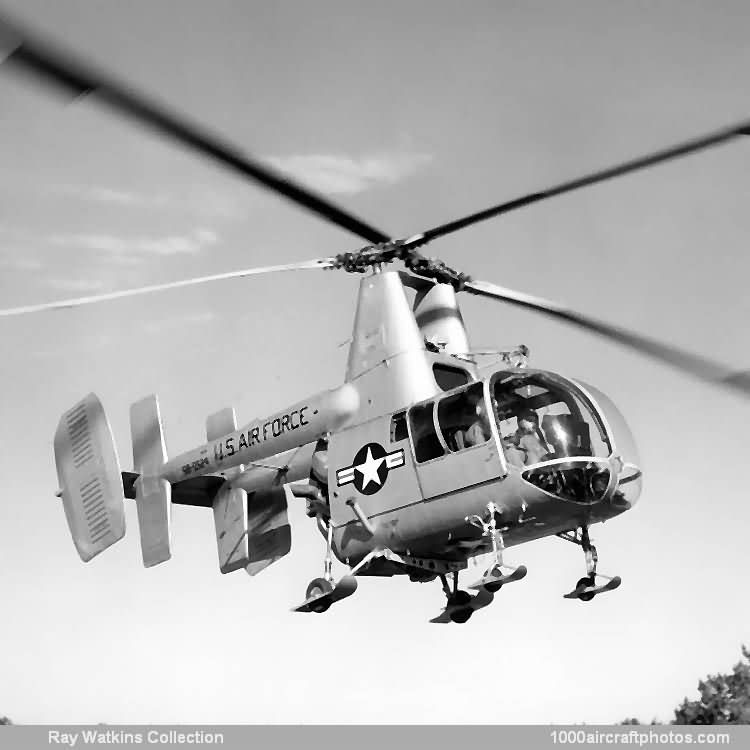01/31/2010. Remarks by Johan Visschedijk: "After winning an US Navy Bureau of Aeronautics design competition for a liaison-type helicopter, the Kaman Model 600 was ordered into production as the HOK-1 for the USMC in 1950 and the similar HUK-1 for the USN, and the first was accepted for service by the USN on April 28, 1953.
The standard HOK/HUK-1 was a general-purpose helicopter which normally carried four or five persons but could be used also for cargo carrying, medical evacuation, search and rescue and air-to-ground photography. As an ambulance it could accommodate two stretcher patients and one sitting patient or medical orderly, in addition to the pilot. Stretcher loading was through the nose. Optional equipment included an externally-mounted hook for cargo hauling and a power hoist.
Featuring the Kaman contra-rotating and intermeshing twin-rotor system with servo-flap control, the rotor blades were attached to the hub only by blade lag hinges, the servo-flaps eliminating blade-pitch change and associated bearings. The movements of the servo-flaps twist the blades, the natural resilience of the blade material being used to obtain torsional deflection. The two rotors could be lined up parallel to each other fore and aft for stowage purposes.
Power plant of the HOK/HUK-1 was a 600 hp Pratt & Whitney R-1340-48 radial engine which was mounted at the rear end of the fuselage at an angle of 35° from the horizontal to give direct drive to the dual rotor gear-box in the roof. The engine was fan-cooled with the shutter-controlled main air inlet between the rotor pylons. Large rear fuselage doors gave complete access to the power plant. Maximum fuel capacity was 100 gal (378 l).
The H-43A was a development of the HOK/HUK-1 for local crash rescue duties with the USAF. It carried a pilot, a rescue crew of three, and a 1,000 lb (450 kg) kit of fire-fighting equipment. A new type of landing gear was developed for the H-43A, consisting of small skis known as "bear-paws" which were able to prevent the helicopter sinking into soft surfaces and so permit operation from snow, sand or mud. A float landing gear was also available.
A turbine-powered development of the piston-engined series was the Model 600-3 H-43B Huskie. The prototype was a modified HOK-1, which was developed and flown under an USAF contract, through the Lycoming Division of AVCO, as a test bed for the first flights of the Lycoming XT53 shaft-turbine. This aircraft flew for the first time on September 27, 1956 and was followed by the first production model of the H-43B in December, 1958.
While the HOK/HUK-1 had a three-fin tail configuration, the H-43A was flown with four fins (shown above), while the H-43B was flown with two fins and two plates above the tail plane, and with two fins and two plates below the tail plane, before the final configuration was settled in a tail unit with twin rudders, controlled by an auto-stabilizer, flanked by two endplates.
The H-43B was powered by a 860 shp (de-rated to 825 shp) Lycoming T53-L-1B shaft-turbine. The control and rotor systems were almost identical with those of the H-43A, but there were major changes in the fuselage and other parts of the helicopter. In particular, the H-43B had twice the usable cabin space and payload capacity of the H-43A, the increased space was gained by mounting the lighter and more compact turbine engine above the cabin and between the rotor pylons, instead of to the rear of the cabin.
Maximum internal width of the cabin was 63 in (1.60m), with 46 in (1.17 m) headroom. The rear of the cabin formed large clamshell doors. Normal fuel capacity was 198 gal (750 l) in two flexible interconnected tanks under the floor, and there was provision for auxiliary tanks with total capacity of 100 gal (377 l). Alternative loads include a pilot, two fully-clothed fire-fighters and 1,000 lb (445 kg) of fire-fighting and rescue gear; pilot, co-pilot and ten passengers; or pilot, medical attendant and two stretcher patients.
In 1962 the remaining aircraft were redesignated: HOK-1 to OH-43D, HUK-1 to UH-43C, H-43A to HH-43A and H-43B to HH-43B.
The final version was the Model 600-5 HH-43F, fitted with a 1,150 shp (derated to 825 shp) Lycoming T53-L-11A shaft-turbine engine. Produced to replace previous models in applications where altitude performance under hot day conditions was required. Normal fuel capacity increased to 350 gal (1,325 l) by utilizing internal auxiliary tankage. First HH-43F flew in August 1964 and several have been delivered under the MAP to Colombia, Thailand, Morocco, Pakistan and Burma.
The pictured H-43A was reportedly referred to as YH-43B probably because it was used to test the H-43B-rotorblades."
